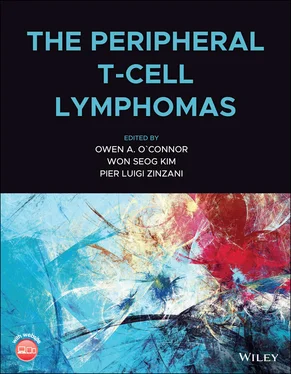Mycosis fungoides and Sézary syndrome were described as early as 1806 [1] and 1938 [2], respectively. However, they were considered to be a histological subtype in a broad group which includes all lymphomas, distinguished from others based on their growth pattern. The Kiel classification, proposed by Lennert and Luke in 1974, was used to classify the lymphomas, based on the tumor morphological and cytological characteristics [3]. It was not until mid‐1970s that they were both recognized to be a spectrum of cutaneous T‐cell lymphomas (CTCL) [4], and it was only in the late 1970s that the T‐cell lymphomas were proposed as a separate entity from B‐cell lymphomas [5].
Subsequently, with better understanding and characterization of the immune system, immunohistochemistry, and immunophenotyping were used to identify several subtypes of T‐cell lymphomas. This was first incorporated to develop the Revised European–American Classification of Lymphoid Neoplasms classification for NHL based on a consensus list by the International Lymphoma Study Group in 1994 [6]. With improved understanding of the diversity and pathobiology of the disease, several classifications have been developed, such as the World Health Organization (WHO) project, and the European Organization of Research and Treatment of Cancer. These classifications have been further refined, incorporating the genetic, immunophenotypic, and pathobiological advances made in this field. T‐cell lymphomas can be divided into those arising from precursor T cells termed as precursor T‐lymphoblastic lymphoma and those of more mature T cells, referred to as peripheral or mature T‐cell lymphomas (PTCLs). The 2017 WHO classification broadly divides PTCL into three categories based on their location. They are leukemic (disseminated), nodal, and extranodal. These categories are further subdivided based on morphology, immunohistochemistry, and clinical behavior. Examples of these lymphomas include PTCL not otherwise specified (PTCL‐NOS), angioimmunoblastic T‐cell lymphomas (AITL), anaplastic large‐cell lymphoma (ALCL), anaplastic lymphoma kinase positive (ALK+), ALK negative (ALK–) ALCL, intestinal T‐cell lymphoma, and breast implant‐associated ALCL (BIA‐ALCL). Since the 2017 WHO classification, numerous developments have resulted in a better understanding of the genetic basis of ALK+, ALK–, gastrointestinal T‐cell and GATA3 subtypes of T‐cell lymphomas. These changes will likely be incorporated into the next edition of the WHO classification [7]. The current WHO classification of T‐cell lymphomas is presented in Appendix 5.A.
PTCLs are a usually clinically aggressive, relatively rare, and heterogeneous group of lymphomas. They constitute about 10–15% of all NHL in the Western countries and 15–20% of all NHLs in Asia [8]. They originate from clonal proliferation of mature post‐thymic lymphocytes. NK‐cell lymphomas are also considered part of the group as NK cells are closely related to T cells. The incidence and prevalence varies in different racial populations and geographical regions [9–11], largely due to host genetic and environmental makeup and prevalence of risk factors, including diseases affecting immunity and virus epidemiology [11].
In an attempt to study the geographical distribution of NHL subtypes, the International NHL Classification Project was conducted in the late 1990s [8]. A total of 1403 cases diagnosed from 1988 to 1990 were included from eight different geographic regions and nine institutions. Of these, 1378 were confirmed to be NHL and were analyzed; 109 cases of PTCL were included (9.4% of 1378), of which 33 were ALCLs. It was found that there were substantial geographical differences in distribution across different types of NHL. A higher percentage of PTCLs were seen in Hong Kong (10%), Cape Town (8%), and London (8%). The incidence in other geographical locations ranged from 1% to 6%. Non‐anaplastic PTCLs (96/129 cases) also revealed geographical variation ranging from 18.3% in Hong Kong to 1.5% in Vancouver. Angiocentric nasal T/NK‐cell lymphomas were almost exclusively seen in Hong Kong (8%) [12].
Subsequently, published in 2008 and confirming the results reported by NHL classification project in regards to differences in geographical distribution of various PTCL subtypes, the International T‐cell Lymphoma Project reported data on 1314 cases of PTCL/NK‐cell lymphomas from 22 centers worldwide with diagnoses between 1990 and 2002. ATLL and NK T‐cell lymphomas were more frequent in Asia (25% and 22.4%, respectively) compared with Europe (1% and 4.3%, respectively) and North America (2% and 5.1%, respectively). In Europe and North America, PTCL‐NOS was the most common subtype (34.3% and 34.5%, respectively). AITL and enteropathy‐associated T‐cell lymphomas (EATL) were more common in Europe compared with North America and Asia, whereas ALK+ ALCLs were most common in North America [10].
In the United States (US), the incidence of T cell lymphomas has been gradually increasing over the past two decades, whereas the incidence of B‐cell lymphomas has plateaued. According to a review of US surveillance, epidemiology and end results cancer database, over a 10‐year period from 2007 to 2016, the incidence rate of T‐cell lymphomas is 2.2 (2.2/1000 patients). Among the T cell lymphomas, PTCLs had the highest incidence (1.2), followed by CTCL (0.6). PTCL‐NOS was the most common subtype of PTCL (0.4), followed by ATLL (0.3), ALCL (0.2), and AITL (0.2). The international PTCL project reported the most common subtypes of nodal T‐cell lymphoma to be PTCL‐NOS (25.9%), AITL (18.5%), ALCL (12%), NK/T‐cell lymphoma (10.4%), hepatosplenic T‐cell lymphoma (HSTL; 1.4%) and subcutaneous panniculitis‐like T‐cell lymphoma (0.9%) [13].
In this chapter, we discuss the epidemiological data for each of the individual subtype of PTCL ( Table 5.1).
Peripheral T‐cell Lymphoma, Not Otherwise Specified
PTCL‐NOS is a heterogeneous group of predominantly nodal T‐cell lymphomas that originate from different types of mature T cells and do not meet the criteria for other specially defined subtypes of PTCL. This is the most prevalent subtype of PTCL seen in Western countries, accounting for approximately 30% of PTCL and approximately 4% of NHLs overall [8, 9, 14–16]. Owing to improved diagnostic methods and awareness of the disease, the incidence of PTCL‐NOS has increased in the United States from approximately 0.1 cases per 100 000 population in 1992 to approximately 0.4 cases per 100 000 population in recent years [17]. In the United States, African Americans have a higher incidence, compared with Asian/Pacific Islanders, Hispanic Whites, and Non‐Hispanic Whites, with American Indian/Alaskan natives having the lowest incidence [18]. As PTCLs account for approximately 15–20% of all NHLs in Asia, the incidence of PTCL‐NOS is higher in Asia compared with the Western world [10].
Typically, the median age at diagnosis is 60–65 years [10, 18], and men have a higher incidence than women, with a ratio of approximately two to one [19].
A history of alcohol consumption and allergies is associated with decreased risk, whereas cigarette smoking, a history of psoriasis, and celiac disease are associated with higher risk for the development of PTCL‐NOS per the InterLymph study [20]. In African Americans, an inverse relationship between PTCL‐NOS and sun exposure was reported in one study [21].
Table 5.1 Major lymphoma subtypes by geographic region
Source: Vose et al. [10].
| Subtype |
Incidence (%) |
| North America |
Europe |
Asia |
| PTCL‐NOS |
34.4 |
34.3 |
22.4 |
| Angioimmunoblastic |
16.0 |
28.7 |
17.9 |
| ALK+ ALCL |
16.0 |
6.4 |
3.2 |
| ALK– ALCL |
7.8 |
9.4 |
2.6 |
| NKTCL |
5.1 |
4.3 |
22.4 |
| ATLL |
2.0 |
1.0 |
25.0 |
| Enteropathy‐type |
5.8 |
9.1 |
1.9 |
| Hepatosplenic |
3.0 |
2.3 |
0.2 |
| Primary cutaneous ALCL |
5.4 |
0.8 |
0.7 |
| Subcutaneous panniculitis‐like |
1.3 |
0.5 |
1.3 |
| Unclassifiable T‐cell |
2.3 |
3.3 |
2.4 |
ALCL, anaplastic large‐cell lymphoma; ALK, anaplastic lymphoma kinase; ATLL, adult T‐cell leukemia/lymphoma; NKTCL, natural killer/T‐cell lymphoma; NOS, not otherwise specified; PTCL, peripheral T‐cell lymphoma.
Читать дальше












